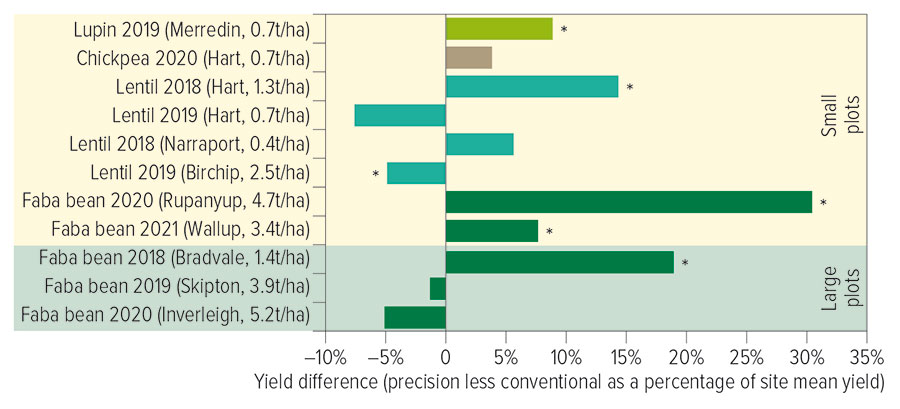Key points
- Trials showed precision seeding improved plant spacing and stand uniformity; however, yields were not consistently better than with conventional seeding
- Regardless of seeding equipment, careful attention to detail is vital to maximise crop establishment and outcomes
Precision seeding trials have shown the system improves the evenness of plant spacing and stand uniformity in pulse crops – however, this did not consistently improve crop establishment or yield.
Precision planters are designed to place seeds at a consistent inter-plant distance and depth to promote uniform emergence and minimise inter-plant competition. They were originally developed for summer row crops, but in recent years there has been increasing interest in adapting the technology to winter crops.
In principle, having plants equally spaced in a crop reduces inter-plant competition and allows each plant to grow to its potential.
Trials conducted between 2018 and 2021 compared precision planting to the conventional sowing of pulses across a range of plant densities. The University of Adelaide led the four-year GRDC investment in collaboration with the University of South Australia, Birchip Cropping Group, Hart Field Site Group, Southern Farming Systems (SFS) and the Western Australian No-Tillage Farmers Association.
Plot trials were sown with a purpose-built small-plot seeder capable of sowing plots either as a conventional disc seeder or a precision planter. The large-scale faba bean trials conducted by SFS compared two commercially available Väderstad seeders – a precision planter versus a conventional system (airseeder in 2018 and seed drill in 2019 and 2020).
Trial results
Precision planting yields were generally comparable to or slightly better than those with conventional sowing. The benefits were often greater at low plant densities, mitigating the effect of low plant numbers on yield.
The eight small-plot experiments with lentils, faba beans and lupins (Figure 1) resulted in:
- four where yield was eight to 30 per cent higher with precision planting;
- one where yield was five per cent lower; and
- three where yields were not significantly different.
Figure 1: The difference in yield between the precision-planted and the conventionally sown treatments in lupins, chickpeas, lentils and faba beans. Positive values show precision planting was better than conventional, negative values the reverse. Captions list the site mean yield at each location. Asterisk denotes significant difference at p=0.05.

Source: Glenn McDonald
The improvements in yield from precision planting in some of the small-plot experiments could be attributed to better crop establishment, but in others higher yields were achieved even at lower plant densities.
The three large-scale trials found that the precision planter improved faba bean yield in the 2018 trial by 18 per cent (from 1.32 to 1.54 tonnes per hectare), despite having a slightly lower plant population (Figure 1). There was no significant difference in yield between the conventional seed drill and the precision planter in the other two trials.
Density matters
Plant density was the main cause of variation in yield. In the small-plot trials, where density was studied in detail, yields declined as plant density fell below approximately 100 plants per square metre in lentils and 20 to 30 plants/m2 in faba beans. When precision planting assisted with yield, the effect was more consistent at low densities.
This might be related to the more-even inter-plant spacing with precision seeding, which resulted in a reduction in variability of between 30 and 50 per cent.
Being able to maintain yields at a lower plant density might allow a reduction in seed input costs. However, the benefits of this could be small in pulses compared to crops such as canola, which has much higher seed costs. For example, a reduction in sowing rate of 10 to 20 plants/m2 in lentils would equate to a saving of less than $1/ha.
While these results are encouraging, the benefits of precision planting remain variable and modest.
Rather than invest in new equipment, careful preparation and seeder adjustment might be a better way of improving crop establishment and outcome. Grower surveys have found that the model and age of a seeder was of much less importance than the operator in achieving good establishment.
More information: Associate Professor Glenn McDonald, 08 8313 7358, glenn.mcdonald@adelaide.edu.au

























































